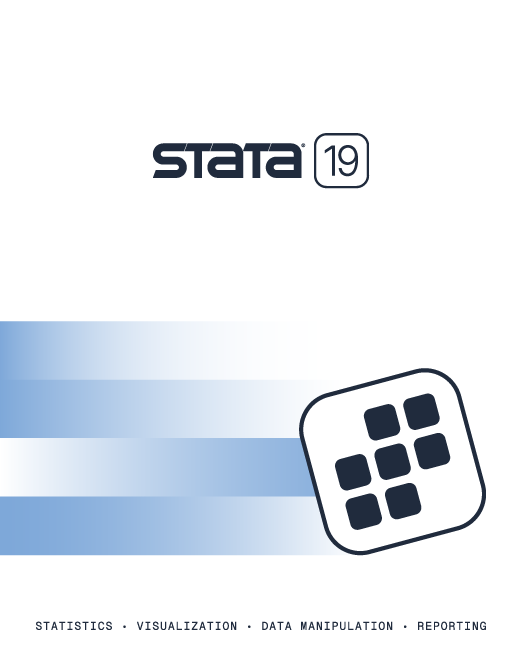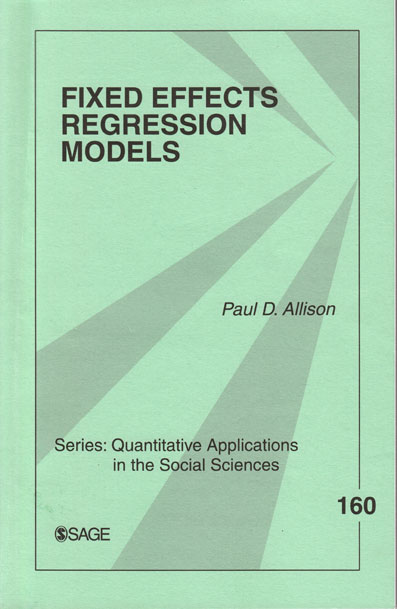

2025 Stata Conference • Nashville, TN • 31 July–01 August
Fixed Effects Regression Models |
||||||||||||||||||||||||||||||||||||
 Click to enlarge See the back cover |

As an Amazon Associate, StataCorp earns a small referral credit from
qualifying purchases made from affiliate links on our site.
eBook not available for this title
eBook not available for this title |
|
||||||||||||||||||||||||||||||||||
Comment from the Stata technical groupFixed Effects Regression Models, by Paul D. Allison, is a useful handbook that concentrates on the application of fixed-effects methods for a variety of data situations, from linear regression to survival analysis. Fixed-effects models make less restrictive assumptions than their random-effects counterparts. For example, fixed-effects models allow unobservable variables to have whatever associations with the observed variables. As Allison points out, the individuals act as their own controls in a fixed-effects setting. That is not to say that fixed-effects models are not without their disadvantages. For example, the effects of covariates that are constant within individuals cannot be measured in this setting. However, such disadvantages should not dissuade one from using this powerful analysis technique that makes the most minimal of independence assumptions. In an appendix, Allison shows how to perform all the analyses by using Stata. |
||||||||||||||||||||||||||||||||||||
Table of contentsView table of contents >> About the Author
Series Editor’s Introduction
1. Introduction
2. Linear Fixed Effects Models: Basics
The Two-Period Case
Extending the Difference Score Method for the Two-Period Case A First-Difference Method for Three or More Periods per Individual Dummy Variable Method for Two or More Periods per Individual Interactions With Time in the Fixed Effects Method Comparison with Random Effects Models A Hybrid Method Summary 3. Fixed Effects Logistic Models
The Two-Period Case
Three or More Periods Interactions With Time A Hybrid Method Methods for More Than Two Categories on the Response Variable Summary 4. Fixed Effects Models for Count Data
Poisson Models for Count Data With Two Periods per Individual
Poisson Models for Data With More Than Two Periods per Individual Fixed Effects Negative Binomial Models for Count Data A Hybrid Approach Summary 5. Fixed Effects Models for Events History Data
Cox Regression
Cox Regression With Fixed Effects Some Caveats The Hybrid Method for Cox Regression Fixed Effects Event History Methods for Nonrepeated Events Summary 6. Structural Equation Models With Fixed Effects
Random Effects as a Latent Variable Model
Fixed Effects as a Latent Variable Model A Compromise Between Fixed Effects and Random Effects Reciprocal Effects With Lagged Predictors Summary Appendix 1. Stata Programs for Examples in Chapters 2 to 5
Appendix 2. Mplus Programs for Examples in Chapter 6
References
Author Index
Subject Index
|
||||||||||||||||||||||||||||||||||||
Learn
Free webinars
NetCourses
Classroom and web training
Organizational training
Video tutorials
Third-party courses
Web resources
Teaching with Stata
© Copyright 1996–2025 StataCorp LLC. All rights reserved.
×
We use cookies to ensure that we give you the best experience on our website—to enhance site navigation, to analyze usage, and to assist in our marketing efforts. By continuing to use our site, you consent to the storing of cookies on your device and agree to delivery of content, including web fonts and JavaScript, from third party web services.
Cookie Settings
Last updated: 16 November 2022
StataCorp LLC (StataCorp) strives to provide our users with exceptional products and services. To do so, we must collect personal information from you. This information is necessary to conduct business with our existing and potential customers. We collect and use this information only where we may legally do so. This policy explains what personal information we collect, how we use it, and what rights you have to that information.
These cookies are essential for our website to function and do not store any personally identifiable information. These cookies cannot be disabled.
This website uses cookies to provide you with a better user experience. A cookie is a small piece of data our website stores on a site visitor's hard drive and accesses each time you visit so we can improve your access to our site, better understand how you use our site, and serve you content that may be of interest to you. For instance, we store a cookie when you log in to our shopping cart so that we can maintain your shopping cart should you not complete checkout. These cookies do not directly store your personal information, but they do support the ability to uniquely identify your internet browser and device.
Please note: Clearing your browser cookies at any time will undo preferences saved here. The option selected here will apply only to the device you are currently using.